
An Academic Experience Regarding the Implementation of the 2018 Classification System of Periodontal Diseases in the Curriculum of the International University for Science and Technology
*Corresponding Author(s):
Aous DannanDepartment Of Periodontology, Faculty Of Dentistry, The International University For Science And Technology, Damascus, Syrian Arab Republic
Tel:963933300485,
Email:aousdannan@yahoo.com
Abstract
After completing the work on the classification of periodontal diseases for the year 1999, the new classification appeared in 2018 carrying wide amendments to the pathogenic mechanisms and terminology associated with it. Accordingly, it was necessary for medical colleges to start working on this classification and adopting it in all theoretical and practical aspects.
This research paper demonstrates the experience of the Faculty of Dentistry at the International University for Science and Technology with regard to the inclusion of the modern classification of periodontal diseases in the educational curriculum, accompanied by a simplified, questionnaire-based descriptive study to perceive the students' opinions on this from their point of view.
In addition to the successful formal inclusion of the modern classification in the university’s curriculum, its systematic implementation had a positive impact on students in terms of acceptance of its general ideas and clinical applications. The students faced most of the difficulties in the “staging” of periodontitis cases, as well as in calculation of the “clinical attachment loss”.
In general, the experience of including the 2018 classification of periodontal diseases in the curriculum of the Faculty of Dentistry was successful when all the studied criteria are taken altogether into account.
Keywords
Classification, Clinical attachment loss; Curriculum, Periodontal disease; Staging
Introduction
Classification systems in medical fields are essential in order to provide a framework within which pathogenetic diseases can be studied and treated in a systematic manner. Additionally, these systems provide clinicians with a way to organize the healthcare needs of their patients [1].
The last time scientists and clinicians in periodontal disease and related fields agreed on a classification system for periodontal disease was in 1989 at the International Workshop on Periodontal Diseases [2]. Subsequently, a simpler classification was agreed upon at the 1st European Workshop on Periodontal Diseases. These classification systems have been used extensively by clinicians and research scientists around the world. Unfortunately, the 1989 classification had many limitations and the need for a revised classification system for periodontal disease was emphasized during the 1996 World Workshop on Periodontal Diseases. In 1997, the American Academy of Periodontology responded to this need and formed a committee to plan and organize an international workshop to review the classification system for periodontal disease, and thus from October 30 to November 2, 1999, the International Workshop on Classification and Conditions of Periodontal Disease was held and a new classification was agreed upon [3]. Periodontal Diseases Classification (1999) continued until 2018, when the American Academy of Periodontology (AAP) and the European Federation of Periodontology (EFP) participated in presenting the new classification of periodontal diseases in the global workshop [4]. This was to replace the Armitage 1999 classification of periodontal disease, which had been in use for nearly two decades. This new, redesigned periodontal disease classification framework included a multidimensional classification system.
In the last few years, Syria faced different harmful internal and external circumstances that had multiple negative effects on the country, and consequently made the wheel of university’s education stand still for a significant period of time, and at best, it had slowed down considerably. In 2021, with the gradual advancement of the educational process in universities, the Department Periodontology at the Faculty of Dentistry in the International University for Science and Technology (IUST) in Syria decided to start including the 2018 classification of periodontal diseases in its syllabus within the course “Periodontics” in the 1st semester of the academic year 2021-2022 after about 3 years of its appearance.
Materials And Methods
The methodology of implementing the 2018 classification of periodontal diseases in the curriculum
The syllabus of “Periodontics” at the Faculty of Dentistry at IUST consists of 4 courses named “Periodontal diseases” and are sequencedas 1 to 4 (i.e., Perio (1), Perio (2) …, Perio (4)).
It was necessary to include the 2018 classification of periodontal diseases in the curriculum in a systematic and gradual manner, and accordingly the following mechanism was adopted in the first semester of the year 2021-2022:
- Perio (1); The inclusion mechanism was developed so that the 2018 classification of periodontal diseases was addressed in the theoretical curriculum in a basic lecture slightly without details, and not in a separate lecture.
- Perio (2); After 3 basic lectures related to diagnostic aspects and basic medical terminology in periodontal diseases, students in the fourth lecture independently received all the items of the 2018 classification of periodontal diseases in details.
- Perio (3); As a first lecture, the students independently received all the items of the 2018 classification of periodontal diseases in details.
- Perio(4); Since this course does not contain a theoretical aspect, its students were summoned to an independent session at the beginning of the semester and they independently received all the articles of the 2018 classification of periodontal diseases in the form of an integrated lecture.
The mechanism for including the 2018 classification of periodontal diseases in the theoretical curriculum has been supported by a parallel mechanism at the level of practical and applied aspects of the courses of Periodontics (2), (3), and(4) that relied on a radical change of the “diagnosis clinical chart” for periodontal diseases that was approved in the clinics of the faculty, where some items were deleted and new items were included that are directly related to the modern classification(e.g. Adding smoking status, whether less or more than 10 cigarettes per day, adding measurement of clinical attachment loss, adding the bleeding on probing score to ensure the health status and/or presence of gingivitis, and finally a diagnosis conclusion with basic aspects) (Figures 1a and 1b).
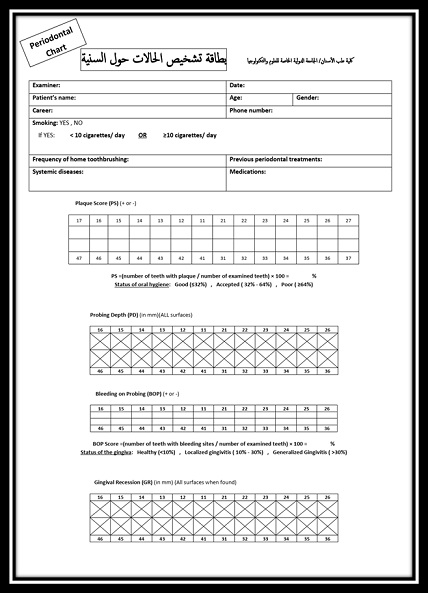
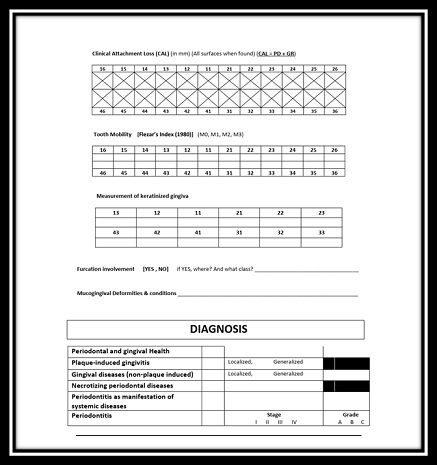 Figures (1a, 1b): The new periodontal chart for diagnosis appointed in the dental clinics at IUST.
Figures (1a, 1b): The new periodontal chart for diagnosis appointed in the dental clinics at IUST.
This auxiliary mechanism has contributed to deepening the concepts of diagnosis of periodontal diseases among students, due to the presence of two sources for receiving information; namely the theoretical side and the practical side.
The adoption of the aforementioned mechanism for the inclusion of the 2018 classification of periodontal diseases in the syllabus has allowed to directly place the classification into scientific application and practice at the same time for all courses simultaneously (i.e., Perio (1), Perio (2) …, Perio (4)) in the same semester, and this will facilitate the subsequent procedures for that starting from the 2ndsemester 2021-2022, as it will be sufficient now to include the 2018 classification of periodontal diseases in the syllabus of Perio (2) only through one lecture (meaning the fourth lecture as explained above) because what follows that decision will have already fulfilled the 2018 classification of periodontal diseases with its folds.
Statistical study to survey students' opinions on the inclusion of the 2018 classification of dental diseases in the curriculum
To ensure an integrated idea of the impact achieved by the inclusion of the 2018 classification of periodontal diseases in the curriculum for students in the IUST, a statistical study was conducted based on a questionnaire consisting of 10 questions distributed to students of the courses Perio (2) and (3) during the lecture and they were asked to answer the questions. The questions were related to the students’ opinion about the inclusion of the 2018 classification of periodontal diseases in their curriculum from their personal perspective, their acceptance of it in terms of subjective understanding, circulation and clinical application in clinics, and the difficulties related to it, in addition to other items.
Results
Questionnaire forms were collected from 177 students (46.6% females and 53.4% males), of whom 41.8% were students in the Perio (2) and 58.2% were students in the Perio (3) (Figures 2&3).
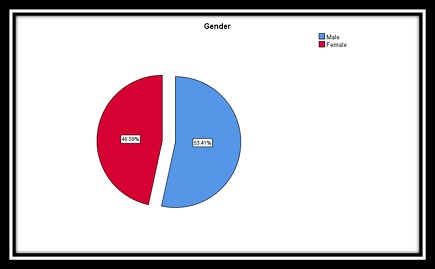 Figure 2: Distribution of students according to gender.
Figure 2: Distribution of students according to gender.
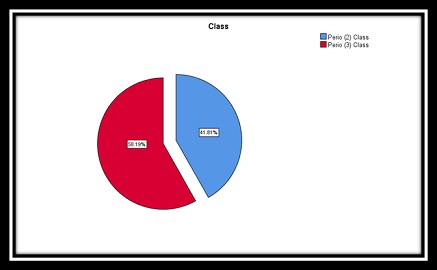 Figure 3: Distribution of students according to class.
Figure 3: Distribution of students according to class.
The results of the statistical study showed that 68.9% of the students were not previously aware of the existence of a New Classification (NC) of periodontal diseases at all (Figure 4).
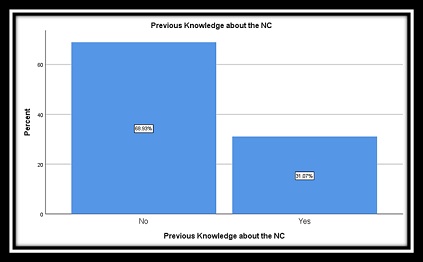 Figure 4: Distribution of students according to previous knowledge about the new classification.
Figure 4: Distribution of students according to previous knowledge about the new classification.
According to Chi-Square test, the difference between both percentages was statistically significant (P < 0.05) (Table 1).
|
Previous Knowledge about the NC |
||||
|
|
Observed N |
Expected N |
Residual |
|
|
No |
122 |
88.5 |
33.5 |
|
|
Yes |
55 |
88.5 |
-33.5 |
|
|
Total |
177 |
|
|
|
|
Test Statistics |
||||
|
|
Previous Knowledge about the NC |
|||
|
Chi-Square |
25.362a |
|||
|
df |
1 |
|||
|
Asymp. Sig. |
0.0001 |
|||
|
a. 0 cells (0.0%) have expected frequencies less than 5. The minimum expected cell frequency is 88.5. |
||||
Table 1: Results of Chi-square test between percentages regarding previous knowledge about the new classification
88.7% of the students were satisfied with having studied the new classification of periodontal diseases in their modified curriculum, and only 6.2% of them expressed that they had no difference in terms of the presence or absence of the new classification of periodontal diseases in their curriculum (Figure 5).
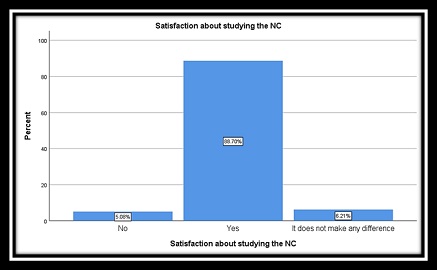 Figure 5: Distribution of students according to satisfaction about studying the new classification.
Figure 5: Distribution of students according to satisfaction about studying the new classification.
According to Chi-Square test, the difference between those percentages was statistically significant (P < 0.05) (Table 2).
|
Satisfaction about Studying the NC |
||||
|
|
Observed N |
Expected N |
Residual |
|
|
No |
9 |
59.0 |
-50.0 |
|
|
Yes |
157 |
59.0 |
98.0 |
|
|
It does not make any difference |
11 |
59.0 |
-48.0 |
|
|
Total |
177 |
|
|
|
|
Test Statistics |
||||
|
|
Satisfaction about studying the NC |
|||
|
Chi-Square |
244.203a |
|||
|
df |
2 |
|||
|
Asymp. Sig. |
0.0001 |
|||
|
a. 0 cells (0.0%) have expected frequencies less than 5. The minimum expected cell frequency is 59.0. |
||||
Table 2: Results of Chi-square test between percentages regarding satisfaction about studying the new classification.
The extent to which students assimilate and understand the new classification of periodontal diseases according to their own expression ranged between (very good) (36.9%), (good) (49.4%), (moderate) (10.8%), and (poor) (2.8%) (Figure 6).
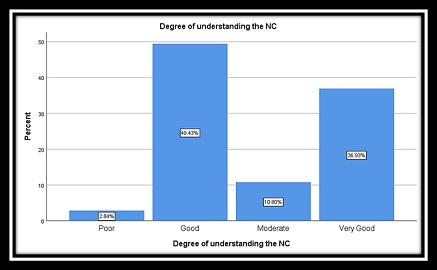 Figure 6: Distribution of students according to degree of understanding the new classification.
Figure 6: Distribution of students according to degree of understanding the new classification.
According to Chi-Square test, the difference between those percentages was statistically significant (P < 0.05) (Table 3).
|
Degree of understanding the NC |
||||
|
|
Observed N |
Expected N |
Residual |
|
|
Poor |
5 |
44.0 |
-39.0 |
|
|
Good |
87 |
44.0 |
43.0 |
|
|
Moderate |
19 |
44.0 |
-25.0 |
|
|
Very Good |
65 |
44.0 |
21.0 |
|
|
Total |
176 |
|
|
|
|
Test Statistics |
||||
|
|
Degree of understanding the NC |
|||
|
Chi-Square |
100.818a |
|||
|
df |
3 |
|||
|
Asymp. Sig. |
0.0001 |
|||
|
a. 0 cells (0.0%) have expected frequencies less than 5. The minimum expected cell frequency is 44.0. |
||||
Table 3: Results of Chi-square test between percentages regarding degree of understanding the new classification
About 71% of the students had prior knowledge of an earlier classification for periodontal diseases (i.e., the 1999 classification of periodontal diseases), of whom, students of Perio (3) course made up the vast majority (49.7%) (Figure 7).
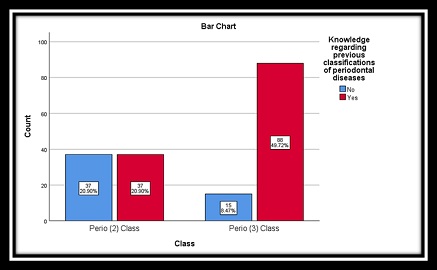 Figure 7: Distribution of students according to knowledge regarding previous classifications of periodontal diseases.
Figure 7: Distribution of students according to knowledge regarding previous classifications of periodontal diseases.
According to Fisher’s exact test, there was a statistically significant relationship between the class and the knowledge regarding previous classifications of periodontal diseases (P < 0.05) (Table 4).
|
|
|||||
|
|
Value |
df |
Asymptotic Significance (2-sided) |
Exact Sig. (2-sided) |
Exact Sig. (1-sided) |
|
Pearson Chi-Square |
26.064a |
1 |
0.0001 |
|
|
|
Continuity Correctionb |
24.384 |
1 |
0.0001 |
|
|
|
Likelihood Ratio |
26.262 |
1 |
0.0001 |
|
|
|
Fisher's Exact Test |
|
|
|
0.0001 |
0.0001 |
|
Linear-by-Linear Association |
25.917 |
1 |
0.0001 |
|
|
|
N of Valid Cases |
177 |
|
|
|
|
|
a. 0 cells (0.0%) have expected count less than 5. The minimum expected count is 21.74. |
|||||
|
b. Computed only for a 2x2 table |
|||||
Table 4: Results of Fisher’s exact test between percentages regarding knowledge about previous classifications of periodontal diseases.
About 74% of the students stated that the new classification of periodontal diseases is not more difficult than the previous classification (1999 classification) from their personal point of view (Figure 8).
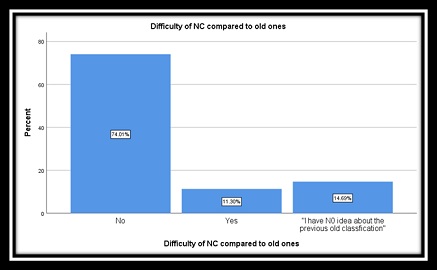 Figure 8: Distribution of students according to difficulty of the new classification compared to old ones.
Figure 8: Distribution of students according to difficulty of the new classification compared to old ones.
Only 33.3% of the students expressed the need for more than one lecture to understand the new classification of periodontal diseases compared to 66.7% who considered that one lecture to deal with the new classification was sufficient (Figure 9).
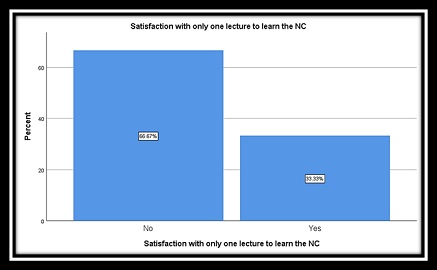 Figure 9: Distribution of students according to satisfaction with only one lecture to learn the new classification.
Figure 9: Distribution of students according to satisfaction with only one lecture to learn the new classification.
According to Chi-Square test, the difference between both percentages was statistically significant (P < 0.05) (Table 5).
|
Satisfaction with only one lecture to learn the NC |
||||
|
|
Observed N |
Expected N |
Residual |
|
|
No |
118 |
88.5 |
29.5 |
|
|
Yes |
59 |
88.5 |
-29.5 |
|
|
Total |
177 |
|
|
|
|
Test Statistics |
||||
|
|
Satisfaction with only one lecture to learn the NC |
|||
|
Chi-Square |
19.667a |
|||
|
df |
1 |
|||
|
Asymp. Sig. |
0.0001 |
|||
|
a. 0 cells (0.0%) have expected frequencies less than 5. The minimum expected cell frequency is 88.5. |
||||
Table 5: Results of Chi-square test between percentages regarding satisfaction with only one lecture to learn the new classification.
Among all diagnostic items associated with the new classification of periodontitis, the majority of students 66.4% reported that they faced the greatest difficulty in determining the 'staging' of periodontitis (i.e., Staging a periodontitis case) (Figure 10).
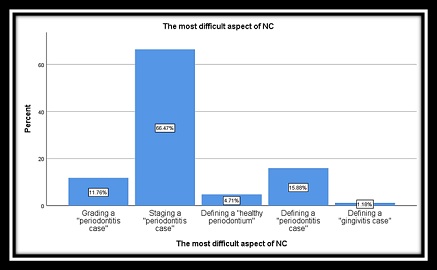 Figure 10: Distribution of students according to the most difficult aspect of the new classification.
Figure 10: Distribution of students according to the most difficult aspect of the new classification.
Measuring the Clinical Attachment Loss (CAL) was the most difficult aspect according to 68% of the students (Figure 11).
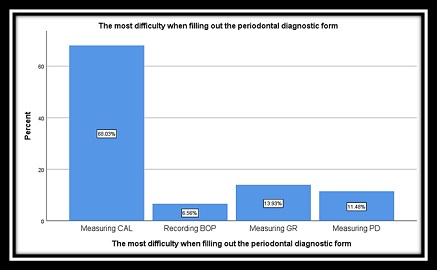 Figure 11: Distribution of students according to the most difficult aspect when filling out the periodontal diagnostic form.
Figure 11: Distribution of students according to the most difficult aspect when filling out the periodontal diagnostic form.
The majority of students (67.2%) considered that the inclusion of the new classification of periodontal diseases in their curriculum was delayed due to the date of its adoption in 2018 (Figure 12).
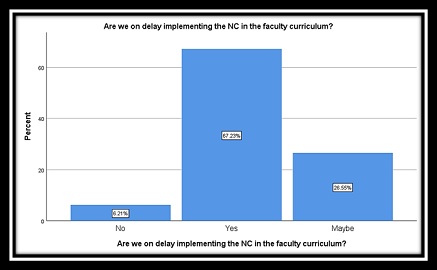 Figure 12: Distribution of students according to considering the new classification as “delayed”.
Figure 12: Distribution of students according to considering the new classification as “delayed”.
About 50.8% of them admitted that there was no gap between the theoretical aspects of the 2018 classification and its practical applications in the clinics of the faculty (Figure 13).
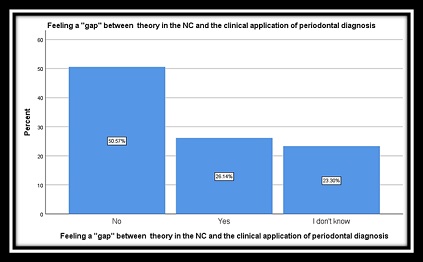 Figure 13: Distribution of students according to considering a gap in the new classification.
Figure 13: Distribution of students according to considering a gap in the new classification.
Discussion
Although 4 years have passed since its appearance in the public domain, our desire in the Department of Periodontology to catch up with the international scientific community led us, at the beginning of 2021, to include the 2018 classification of periodontal diseases in the syllabus of the periodontal pathology course. According to a systematic mechanism, the classification has been included in a way that ensures that students of all periodontal courses take it and make it a part of their curriculum.
The above-mentioned inclusion mechanism has been designed to ensure that the 2018 classification of periodontal diseases is included in the curriculum for the upcoming semesters as follows:
- Students of the periodontal course (2): The 2018 classification of periodontal diseases will be present in their syllabus in the fourth lecture.
- Students of the periodontal course (3): There is no need for any action, since the students have taken up the modern classification in a previous course (i.e., periodontal course (2)).
- Students of the periodontal pathology course (4): There is no need for any action, since the students have dealt with the modern classification in a previous course (i.e., periodontal course (3)).
The ignorance to start including the 2018 classification of periodontal diseases in the syllabus for students of the periodontal course (1) in the form of an independent integrated lecture is due to the urgent need for the existence of general principles, medical terminology and basic concepts related to periodontal diseases in general before dealing with the classification, and this is what it cannot be achieved in the curriculum of these students.
A simplified statistical questionnaire was conducted among the 177 students of the courses of periodontal diseases (2) and (3) to determine their response, understanding and personal perspective to the inclusion of the 2018 classification of periodontal diseases in their curriculum. In general, the results showed that the majority of students (88.7%) were satisfied with their study of the new classification of periodontal diseases in their modified syllabus, with (good) comprehension and understanding for about 50% and (very good) for about 37% of them, without the need, according to the expression of the majority of them (66.6%), for more than one lecture to captivate the new classification. We believe that the implementation of the new classification in the students’ curriculum was of great importance since about 69% of them had no previous knowledge about it.
On a clinical basis, dealing with the new classification requires some practicing under direct supervision for students, since it contains new terminologies such as “Staging”, “Grading”, new definitions of “healthy gingiva”, “gingivitis”, and “periodontitis” cases [5]. When it comes to clinical application, the majority of students (66.4%) considered “staging a periodontitis case” as the most difficult aspect in the new classification. This should push our future plans in the faculty to shed more light on those terminologies with more emphasis on the clinical aspects of the new classification.
In periodontal diagnosis, Probing Depth (PD) measurement alone is inadequate for an assessment of periodontitis. Thus, clinical attachment loss is usually assessed by adding the extent of gingival recession to the probing depth measurement to estimate the total extent of tissue loss from the Cemento Enamel Junction (CEJ) of the tooth [6]. However, according to our results, the measurement of “Clinical Attachment Loss” per se presented the most problematic issue for 68% of students, especially when gingival recession is not present. Some researchers prefer measuring the PD at the first place as an easier predictor for future progress of the disease [7]. Such an issue forces us in the Department of Periodontology to pay more attention to the Consolidation of the (CAL) measurement concept from the theoretical and practical sides in the future.
Conclusion
As a conclusion, we can say that the experience of including the 2018 classification of periodontal diseases in the curricula of the courses of periodontics in the Faculty of Dentistry at the International University for Science and Technology in Syria was successful when all the studied criteria are taken altogether into account. To our knowledge, this is the first study in Syria that shed light on implementing a new classification system for periodontal diseases in the curriculum of a dental school.
References
- Malterud K, Hollnagel H (1997) The magic influence of classification systems in clinical practice. Scandinavian journal of primary health care. 15: 5-6.
- American Academy of Periodontology (1989) Proceedings of the world workshop in clinical periodontics. American Academy of Periodontology.
- Armitage GC (1999) Development of a classification system for periodontal diseases and conditions. Annals of Periodontology 4: 1-6.
- Caton JG, Armitage G, Berglundh T, Chapple ILC, Jepsen S, et al. (2018) A new classification scheme for periodontal and peri-implant diseases and conditions - Introduction and key changes from the 1999 classification. Journal of Periodontology. 89: 1-8.
- Papapanou PN (2018) Consensus report of workgroup 2 of the 2017 World Workshop on the Classification of Periodontal and Peri-Implant Diseases and Conditions. Journal of Periodontology 89: 173-82.
- Newman MG, Carranza FA, Takei HH, Klokkevold PR (2006) Carranza's clinical periodontology. Elsevier, Brazil.
- Sutthiboonyapan P, Wang H-L, Charatkulangkun O (2020) Flowcharts for easy periodontal diagnosis based on the 2018 New Periodontal Classification. Clinical Advances in Periodontics 10: 155-60.
Citation: Dannan A (2022) An Academic Experience Regarding the Implementation of the 2018 Classification System of Periodontal Diseases in the Curriculum of the International University for Science and Technology. J Clin Stud Med Case Rep 9: 0139.
Copyright: © 2022 Aous Dannan, et al. This is an open-access article distributed under the terms of the Creative Commons Attribution License, which permits unrestricted use, distribution, and reproduction in any medium, provided the original author and source are credited.

